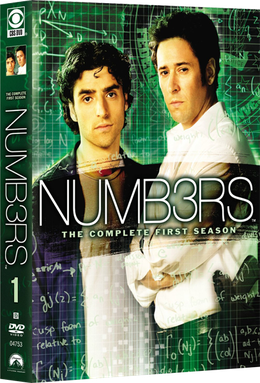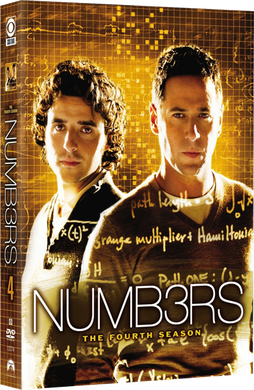Rodney is an American television sitcom starring stand-up comic and country music singer Rodney Carrington that aired on ABC from September 21, 2004, to June 6, 2006. Executive producer Ric Swartzlander, Don Reo, and Damon Wayans were the creators of the series.

Numbers is an American crime drama television series that was broadcast on CBS from January 23, 2005, to March 12, 2010, for six seasons and 118 episodes. The series was created by Nicolas Falacci and Cheryl Heuton, and follows FBI Special Agent Don Eppes and his brother Charlie Eppes, a college mathematics professor and prodigy, who helps Don solve crimes for the FBI. Brothers Ridley and Tony Scott produced Numbers; its production companies are the Scott brothers' Scott Free Productions and CBS Television Studios.

The first season of Numbers, an American television series, premiered on January 23, 2005 and finished on May 13, 2005. The first season sees the start of the working relationship between Don Eppes, an FBI agent, and his genius brother Charlie, an applied mathematician and professor at a local university. The rest of Don's FBI team consists of Terry Lake and David Sinclair. Don and Charlie's father, Alan Eppes, provides emotional support for the pair, while the brilliant Professor Larry Fleinhardt and promising doctoral student Amita Ramanujan provide mathematical support and insights to Charlie.

The second season of Two and a Half Men originally aired between September 2004 and May 2005. The season consisted of 24 episodes. The DVD was released on January 8, 2008.

The third season of Two and a Half Men originally aired between September 2005 and May 2006 on CBS, to positive reviews.

The third season of Numbers, an American television series, premiered on September 22, 2006 with the episode "Spree" and had its season finale "The Janus List" on May 18, 2007. Charlie and Amita intensify their relationship, as do Larry and Megan. Amita has troubles adjusting in her new role as a CalSci professor, and Larry announces his leave of absence—he will be on the space station for six months, which greatly distresses Charlie. Dr. Mildred Finch, the newly appointed Chair of the CalSci Physics, Mathematics, and Astronomy Division, initially troubles Charlie and his colleagues, as Alan dates her. Don dates Agent Liz Warner, questions his ethics and self-worth, and receives counseling. Charlie sees Don's therapist and the two understand one another more. Alan engages in some FBI consulting with his knowledge of engineering, and Larry returns from the space station, although disillusioned. The finale wraps up with a revelation that shakes the whole team.

The fourth season of Numbers, an American television series, first aired on September 28, 2007 and ended on May 16, 2008. Because of the Writers Guild of America strike, only 12 episodes were initially produced for this season. Following the end of the strike, six more were announced.

The fifth season of Numbers, an American television series, first aired on October 3, 2008 and ended on May 15, 2009. The season premiere was moved back one week as a result of the presidential debates.

The sixth and final season of Numbers, an American television series, first aired on September 25, 2009 and ended on March 12, 2010, on CBS. This season featured only 16 episodes.
"Harvest" is the 14th episode of the second season of the American television show Numbers. Inspired by a Christian Science Monitor article about organ tourists, people who travel to a different country to give their organs for money, and an algorithm developed in the United States, the episode features Federal Bureau of Investigation (FBI) agents and mathematicians attempting to locate a missing organ tourist before she is killed.
"Spree" is the first episode of the third season of the American television show Numbers The episode features Federal Bureau of Investigation (FBI) agents pursuing a couple of spree killers. Series writer Ken Sanzel drew inspiration for the episode from pursuit curves. "Spree" also launches a more general trend toward the serialization of the series.
"Two Daughters" is the second episode of the third season of the American television show Numbers. The second half of a two-episode storyline, the episode features the aftermath of a Federal Bureau of Investigation (FBI) Special Agent's abduction, which results in the search for not only the agent and her kidnapper but also for the true motive of the spree killings in the previous episode. As a character development, one FBI Special Agent's actions during the case created a story arc for that character for season three. Series writer Ken Sanzel used the trawler problem, a real-life application used to find traveling boats, as inspiration for the mathematics included in the episode.
"Killer Chat" is the 11th episode of the third season of the American television show Numbers. In the episode, Federal Bureau of Investigation (FBI) agents investigate the murders of several child molesters while a pair of mathematicians prepare to say goodbye to a friend. Stories about child molesters and his own experiences as a parent inspired series writer Don McGill to write the episode.
"Nine Wives" is the 12th episode of the 3rd season of the American television show Numbers. Paralleling the Warren Jeffs and David Koresh cases, the episode features Federal Bureau of Investigation (FBI) agents and mathematicians attempting to locate and arrest the leader of a polygamist cult in which members marry young girls. Julie Hébert, a series writer, incorporated slave quilts and Levy flight into her script. She also included two explosions in the script.
"The Janus List" is the 24th episode and the season finale of the third season of the American television show Numbers. In the episode, a Federal Bureau of Investigation (FBI) team investigate a former triple agent's claims of someone poisoning him.
"When Worlds Collide" is the 18th episode and the season finale of the fourth season of the American television show Numbers. In the episode, two brothers, one a Federal Bureau of Investigation (FBI) Special Agent and the other a mathematician, disagree with each other on the issue of academic freedom after one of the mathematician's friends is arrested on terrorism charges. Series creators Cheryl Heuton and Nicolas Falacci, who wrote the episode, first mentioned the idea for the brothers' conflict during a season two commentary. When Heuton and Falacci wrote the episode for season four, their episode launched a story arc that was later resolved during season five.
"Angels and Devils" is the 23rd episode and the fifth season finale of the American television show Numbers. In the episode, Federal Bureau of Investigation (FBI) agents search for a mathematician who has been kidnapped by a cult leader. The episode ended with a character's priorities changed and a marriage proposal left unanswered. James Callis guest-starred as the cult leader, Mason Dureya.
"Cause and Effect" is the 16th episode and the season finale of the sixth season and series finale of the American television series Numbers. In the episode, Federal Bureau of Investigation (FBI) agents and mathematicians attempt to find one agent's gun before it is used in a violent crime. When series creators/executive producers Cheryl Heuton and Nicolas Falacci learned that the number of episodes airing during the season was reduced, they felt that they needed to finish storylines in case the series was cancelled. To do so, they wrote an open-ended story to serve as either a season finale or a series finale.
"Arrow of Time" is the 11th episode of the fifth season of the American television show Numbers. In the episode, Federal Bureau of Investigation (FBI) agents track an escaped prisoner who is seeking revenge against one of their own. Written by series writer/executive producer Ken Sanzel, the episode continued two storylines. The first storyline continued one that began with two episodes shown very early in season three. The other was originally launched in the season four season finale "When Worlds Collide".








